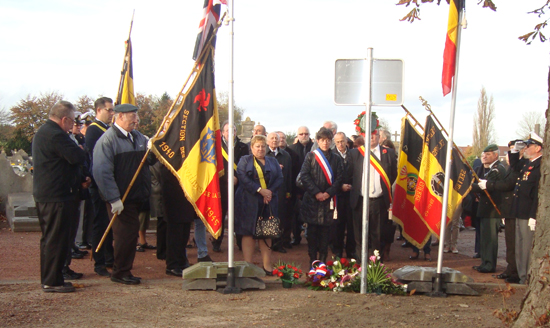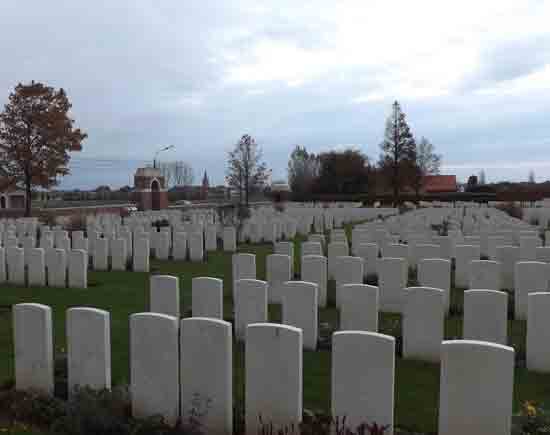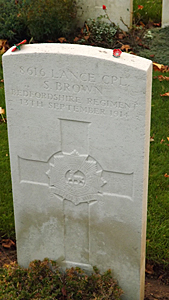A few miles from the French border lies the Belgian village of Quaregnon, today an unassuming hamlet amid endless fields and woodland but 100 years ago the focus of German and British attacks.
Its name meant nothing to me until my brother and I received invitations from the town’s Mayor, Jean-Pierre Lepine, informing us that our maternal great uncle, Lance Corporal Solomon Brown, had lost his life nearby and had originally been buried in the local cemetery.
Solomon was killed near Quaregnon 100 years ago during one of the first British offences of the Great War. The 1901 census lists him as a 14-year-old errand boy and ten years later, after going to sea, he had settled in the West Indies. He returned to fight for his country and fell on 13 September 1914, aged 27 and unmarried. His local newspaper in Hertfordshire reported that he was wounded at the Battle of Mons and died three weeks later.
 My brother and I were part of a small group of soldiers’ relatives who had been contacted by an amateur historian living in Quaregnon, Phillipe Caudron, and invited to help the village commemorate the centenary of the start of the Great War. During the opening event this last weekend the mayor told us few relatives and an audience of 200 villagers, dignitaries and others about Quaregnon’s ordeal and concluded that this war didn’t teach us any lessons because many wars have followed since.
My brother and I were part of a small group of soldiers’ relatives who had been contacted by an amateur historian living in Quaregnon, Phillipe Caudron, and invited to help the village commemorate the centenary of the start of the Great War. During the opening event this last weekend the mayor told us few relatives and an audience of 200 villagers, dignitaries and others about Quaregnon’s ordeal and concluded that this war didn’t teach us any lessons because many wars have followed since.
Local historian Willy Thomas went on to recount how in one single massacre, on 24 August 1914, 63 civilians lost their lives in the village square when German soldiers lined them up against a wall and shot them. The British Northumberland Regiment had settled in the north of the village and Germans set fire to nearly all the houses they’d billeted, some of which had almost become small forts. He described how the café owner’s young daughter, when the family tried to escape, was caught by a German soldier who cut off her arm with his sabre. The mayor, the town’s doctor, operated on her and miraculously, she survived.
We proceeded to the local cemetery in Quaregnon with flag-bearing Belgian veterans leading the way. The Mayor and Jean-Pierre Roland, President of the Veterans Committee, unveiled a plaque commemorating the 63 villagers who died in the massacre. The plaque also acknowledged the eight British soldiers and 24 German soldiers who had been buried there.
 On Sunday, the climax of the weekend, we set off by bus to our ancestors’ final resting place. The Commonwealth War Graves Commission had moved the men’s remains to the Cement House cemetery in the village of Langemark in west Flanders in the 1953.
On Sunday, the climax of the weekend, we set off by bus to our ancestors’ final resting place. The Commonwealth War Graves Commission had moved the men’s remains to the Cement House cemetery in the village of Langemark in west Flanders in the 1953.
Eventually, as the sun was setting and after a few wrong turns, we found it and were met with the sight of 3,500 identical white tombstones stretching to the dusky horizon. Many had names carved on, although some simply read “A Soldier of the Great War … known unto God”, the remains beneath them unidentified.
 One of the descendants had come all the way from Ontario in Canada. Linda Scott, a 66-year-old Catholic, had traced her late husband’s grandfather’s burial site to this particular war grave in Quaregnon. She had lost her husband nearly 20 years earlier and this journey had helped her find a way of honouring her husband’s memory.
One of the descendants had come all the way from Ontario in Canada. Linda Scott, a 66-year-old Catholic, had traced her late husband’s grandfather’s burial site to this particular war grave in Quaregnon. She had lost her husband nearly 20 years earlier and this journey had helped her find a way of honouring her husband’s memory.
We found our great uncle’s grave. Here was an ancestor who had died many decades before my brother and I were born but who along with countless others gave up their young lives.
I felt very privileged to be at his graveside, which is something no member of his family – and possibly no one at all – had done before.


 Loading ...
Loading ...
What do you think?
You can post as a subscriber user ...
User comments (0)